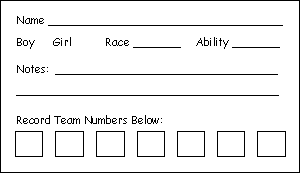.
.
.
.
.
- Write each student's name on an index card.
- Deal the cards into 4 equal piles according to student ability (High, Medium High, Medium Low, and Low)
- Choose one card from each pile. Be sure to include a mix of students (according to gender, race, and personality). Set this stack aside as Team 1.
- Form the remaining teams in the same way. Assign a team number to each stack of cards.
- On a separate sheet of paper, record the name of each team and its team members. That way you'll have something to refer to the next time you form teams. You don't want kids to end up on the same teams over and over.
Note: This method really isn't much harder than the "quick and easy" method, but it has more steps. You will also need to download a copy of the Team Formation Cards.
Sample Team Formation Card:
Steps:
- Duplicate enough Team Formation cards so that you have one card for each student in the class. Never show these cards to your students!
- Write each students' name on a card, circle "boy" or "girl," and fill out the section on race.
- For ability, decided if the student is High (H), Medium High (MH), Medium Low (ML), or Low(L). The numbers of students for each category need to be roughly the same. This judgement is very subjective and can include areas such as leadership ability, willingness to work hard and complete homework, organization skills, ability to follow directions, and so on.
- In the Notes section, write down any miscellaneous information such as learning disabilities, personalities, special needs, etc.
- After you fill out the cards, spread them out in rows on a table. For this example we will assume you have 28 students in your class, which means you will have 7 students in each category.
- Start by placing your 7 highest students in one COLUMN. Your Highs can be thought of as the leaders in your class; these are the kids you can count on to lead the group in a positive direction. Next, place your 7 Medium High students in a column beside the Highs. Continue with a column for the Medium Lows and the Lows.
- When you finish, you will have an array of cards that is 4 columns wide and 7 rows high. As you look over the array of cards, picture each ROW as a team. Look across each row and decide if you need to switch some cards to make the team more balanced. Do you have two boys and two girls? Do you have one High, one Medium High, one Medium Low, and one Low student? Does each team accurately represent the ethnic composition of your class? Will the students get along with each other? Look at all the teams and continue switching cards in each column until you have teams that are as heterogeneous as possible.
- It's important to have a way of keeping track of who has been on which team. The Team Number boxes will help you remember who has been on each team throughout the year. After forming teams, record each student's team number in the box on the bottom of his or her card. To assign team numbers, start with the top row and call it Team 1. Write a 1 in the first box on every team member's card. The next team becomes Team 2, so write the number 2 in the first box on their cards. Continue with all 7 teams. After six weeks have passed and you form new teams, you will be able to see at a glance who was on each team. That way you can make sure that most students are placed with new team members each time.
.
.
.
.
• Numbered Heads: If there are thirty students in class and you want groups of three, count off by ten and have students with the same number find each other.
• Playing cards: Distribute playing cards according to the number in the class. Students search to find others with the same number and form a group. The suits can denote roles if these are being used in the activity. E.g. hearts are the recorders, clubs are the encourages etc.
• Fairy Tale Characters: All those characters from the same story are in the same group. The characters could be mined to extend this activity.
• Famous Pairs: Each person is given a card with a famous name on it and they must non-verbally find their partner by miming this person's achievements. A famous pair could be Torvill & Dean, Beavis & Butthead etc.
• Famous Person: Stick the name of a famous person, animal or object on students' backs and have them discover who they are by asking yes/no questions of their classmates. They must ask each person only one question. .'They then join together with similar people, creatures, objects or themes.
• Coloured Stickers: Put coloured stickers on the backs of students. Children find the other students with the same coloured stickers without speaking.
• Birthday Line: Students line up in order of their birth date without speaking. Then they number off according to the required group size.
• Sound Groups: Give students the name of different tunes or animals. At a signal they all hum their tune or make the noise of their animal. Students must locate the group who will be making the same noises.
http://members.ozemail.com.au/~aacedu/aacetips/thirdedition.htm
